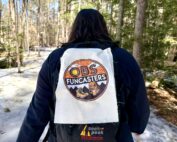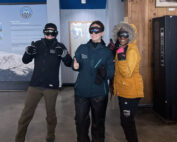Interning in the Clouds: My Mount Washington Odyssey
By Jordan Frate
Now that my time as the 2023 fall intern for the Mount Washington Observatory is coming to an end, I would argue that my abilities as a forecast meteorologist and research scientist have vastly improved. Coming from Maui, Hawaii, Mount Washington has provided me with many first experiences. Mount Washington has given me my first experiences with: wind chills below 0 degrees Fahrenheit, hurricane force winds, a blizzard, or even shoveling snow. Throughout my internship I have witnessed the breaking of various records. I was on shift when we shattered the record for the wettest summer season and I was also present for when record daily temperature maximums were exceeded. In short, I quickly discovered why Mount Washington has earned its title “Home of The World’s Worst Weather.”

The morning after my first blizzard on October 17th.
During my undergraduate years at Oregon State University, I spent much of my time studying the different climate and atmospheric processes that influence weather. Working alongside experienced meteorologists has given me the opportunity to learn just how detailed and complex weather forecasting can be. The combination of common storm tracks, local topography, mountain prominence, and wind direction are all important factors one must take into account when forecasting weather for the higher summits. These factors are difficult to incorporate into weather models which can often result in inaccurate forecasts from valley locations. Maintaining consistent and accurate weather forecasts along the higher summits can help to prevent unnecessary deaths as the higher summits receive many through hikers on a daily basis. In other words, I learned just how essential weather forecasting from the Mount Washington Observatory can be.
I have been extremely invested in my work here at Mount Washington, but that is not to say that my time with the Observatory has been all work and no play. I have had various opportunities to hike over to neighboring AMC huts or even local peaks such as Mount Clay. While I do enjoy hiking, my favorite memories here at Mount Washington typically revolve around the times I’ve spent with the crew afterhours as we gather together on the observation deck for breathtaking sunrises and sunsets.

The observatory crew enjoying a beautiful September sunset.
Not only have I grown as an aspiring meteorologist but I have also grown as an individual. Learning about the history and culture of Mount Washington has been extremely fascinating. Before Mount Washington had closed for the season, it was common practice for the intern to lead several tours of the Observatory. Throughout these tours I would address what processes influence the extreme weather Mount Washington experiences and take our guests up to the tower where they can see how our instruments work first hand. I felt that not only was I teaching the summit visitors about the area, but their stories would give me unique perspectives as many of our guests were thru-hikers or captivated fans. Because this has been my only exposure to the New England area, I aimed to absorb every ounce of information I could get my hands on.
Not only was I able to communicate to the public through the higher summits forecasts and tours, but I was also responsible for outgoing radio forecasts. Every morning at 7:00 am sharp the Mount Washington Observatory reports their higher summits forecast over the radio. This radio forecast is meant to inform the local AMC Huts and their guests of what weather they can expect. This is an important daily task because some locations are beyond cell service and cannot access these reports otherwise. I find that on days where hurricane force winds are expected, a heads up is appreciated. Radio calls and station tours have been an extremely effective way in which I have practiced communicating science. These tools have helped to further develop my understanding of important weather phenomena.
As one may expect, the extreme weather can be overwhelming. From my experience, the elevated wind speeds are what give Mount Washington its reputation for extreme weather. I was fortunate enough to witness triple digit winds on 2 separate shifts where peak wind gusts reached 101 mph. I couldn’t reach the all-time record of 231 mph but felt satisfied with my 101 mph. I was baffled to see people coming up the cog or the auto road in sustained winds of 85+ mph, but to many, the elevated winds are the appeal of Mount Washington. Others, those who failed to read our higher summits forecast, often lost hats, gloves, or other small items before scurrying towards the safety of the Sherman Adams building.
My work on Mount Washington has varied significantly from analyzing local lapse rates to tracking extratropical cyclones. I was often in contact with several different National Weather Service stations to obtain their weather balloon sounding information. I would then use this information to calculate the lapse rate and compare it to the observed lapse rate here on Mount Washington. This was a valuable experience as this has helped me to progress my python programing skills and eventually led to an amazing opportunity where I could job shadow at the National Weather Service. My primary research project while working on the summit was focused on developing an accurate method for extratropical cyclone tracking. Months of research and python programming have allowed me to develop a cyclone tracking method capable of identifying the times, coordinates, and corresponding sea level pressures for extratropical cyclones. I then used this method to identify extratropical cyclones that have occurred across the United States within the last 24 years. This specific project focuses on winter months (December, January, and February) spanning from December 1999 through February 2023. Before any significant trend analysis can be done, I would like to extend this dataset. One day, both of these projects will be completed, and with luck, I will become a published scientist.

A simple plot displaying all 343 mid-latitude cyclone tracks from the cyclone tracking research project.
None of this would have been possible without the amazing staff at the observatory. I am forever grateful to have had such an amazing opportunity and will definitely make my way back to the summit at some point in my future.
Team Flags Return for Seek the Peak’s 25th Anniversary
Team Flags Return for Seek the Peak's 25th Anniversary By MWOBS Staff Mount Washington Observatory is looking forward to continuing a much-loved tradition for Seek the Peak’s 25th Anniversary: Team flags. In inviting teams
Meet Summer Interns Zakiya, Max and Maddie
Meet Summer Interns Zakiya, Max and Maddie By MWOBS Staff We are excited to welcome six teammates to the summit of Mount Washington this summer! During their internship, these students and graduates will play
Saying Goodbye to the Summit
Saying Goodbye to the Summit By Alexis George After an extraordinary last three years working as a Weather Observer and Meteorologist, I am excited to pursue a different career. As sad I as am




